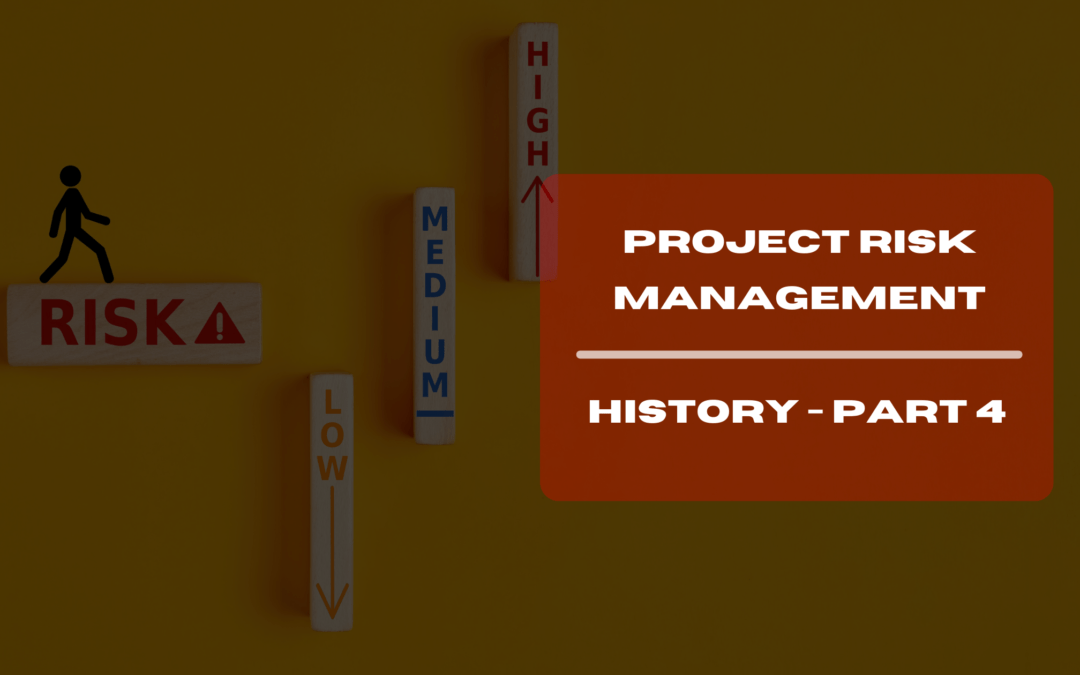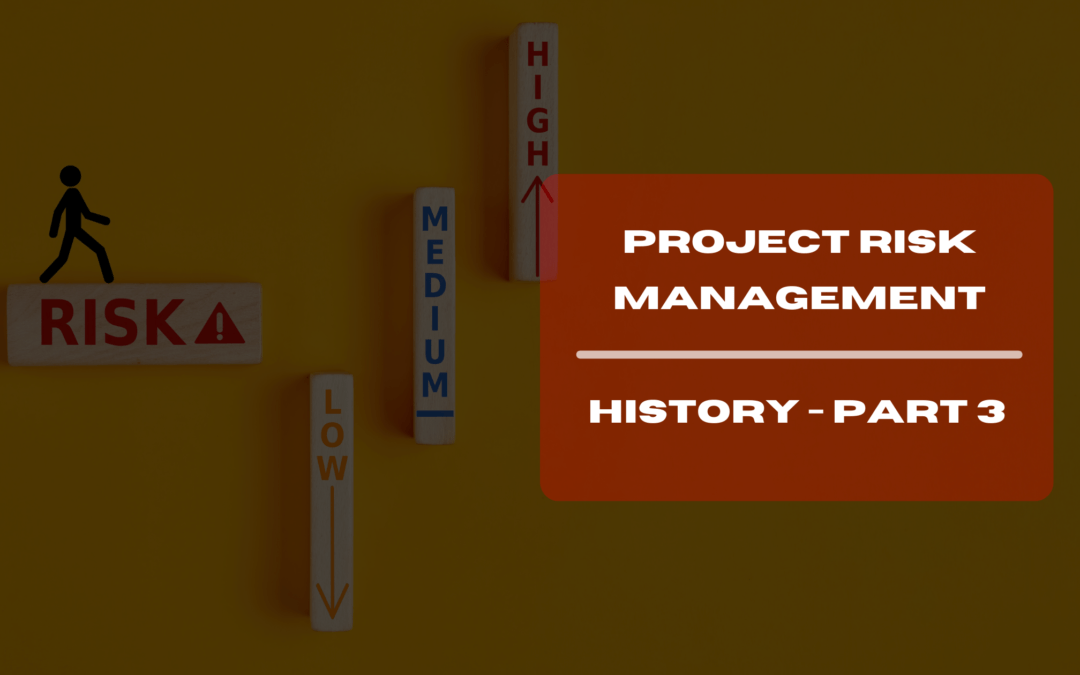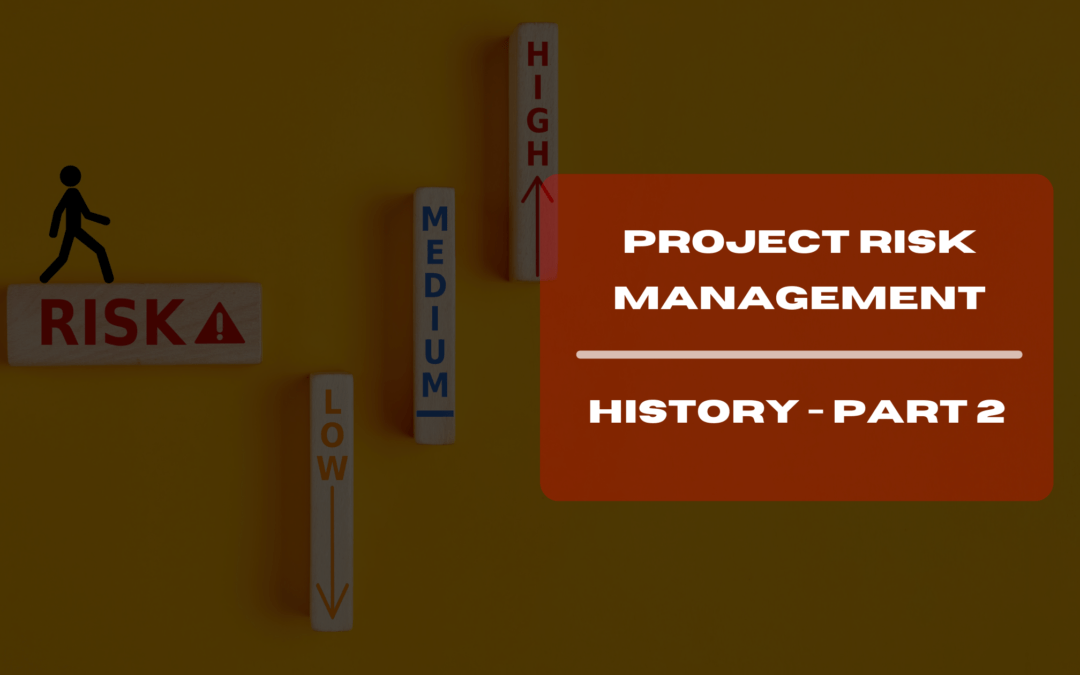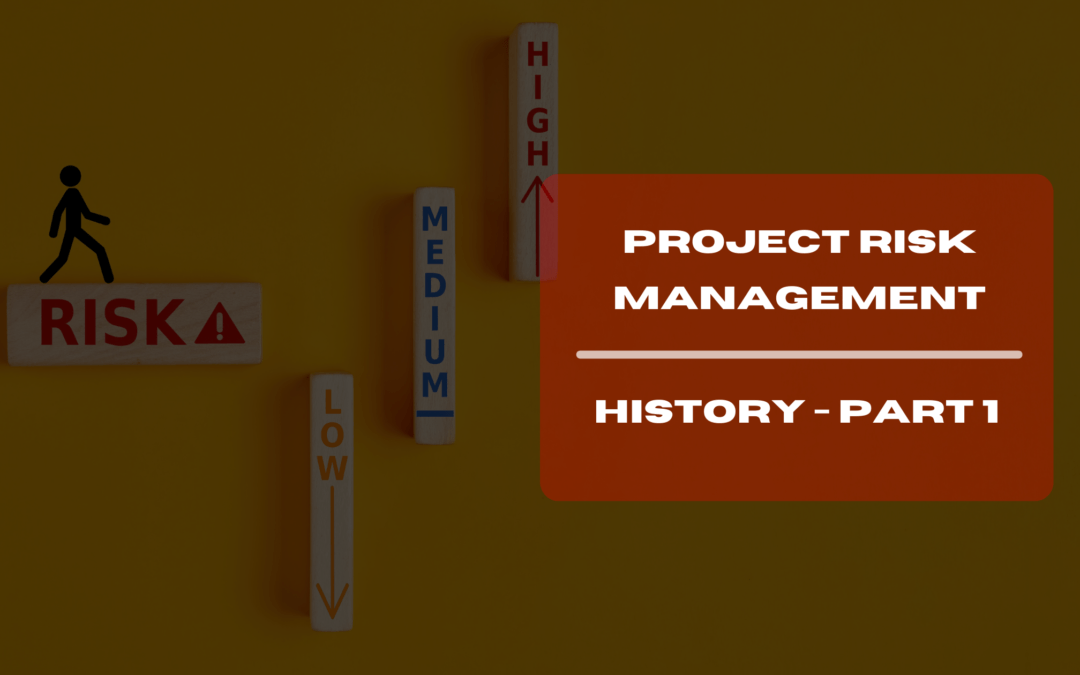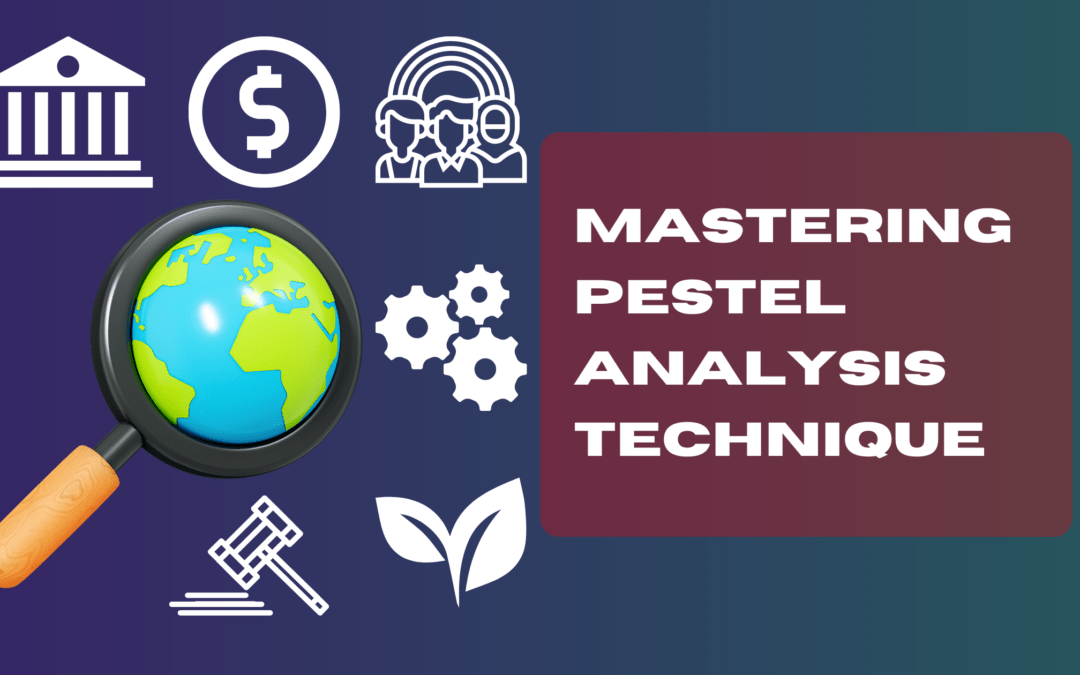
by VenuNataraj | Project Management, Construction Project Management, Risk Management
The history of Project Risk Management: Part 4
As we bring our exploration of the historical context of project risk management to a close, it’s essential to reflect on the significance of understanding this rich history for both students and professionals in the construction project management field.
If you want to refer the previous Parts, you can read them here:
The Roots of Project Risk Management: Part 1
The Roots of Project Risk Management: Part 2
The Roots of Project Risk Management: Part 3
The Relevance of History
History is often perceived as a subject of the past, but in the realm of project risk management, it is a living and breathing entity. The history of how we have grappled with risks in construction projects is a source of valuable lessons. By studying this history, students and professionals can:
- Gain Insights: Historical context provides insights into the challenges and solutions of the past. Understanding the problems our predecessors faced and how they overcame them can inform our approach to risk management today.
- Enhance Decision-Making: Informed decision-making is a cornerstone of effective project risk management. Historical knowledge enables professionals to anticipate risks, evaluate potential consequences, and make proactive decisions to mitigate them.
- Embrace Innovation: History shows that the construction industry has always evolved to meet new challenges. Today, with advancements in technology and methodologies, it is essential to embrace innovation and adapt to changing circumstances.
- Build a Risk Culture: A risk-aware culture is essential for effective risk management. By appreciating the historical context, organizations can foster a culture where risk identification and mitigation are embedded in every project.
- Avoid Repetition: Learning from history helps us avoid repeating the mistakes of the past. It enables us to recognize patterns and take preventive measures to minimize the recurrence of similar risks.
The Evolving Discipline
Project risk management in construction is a field in constant evolution. It draws from diverse disciplines, including engineering, economics, psychology, and statistics. By recognizing its historical roots and understanding how various models and methodologies have emerged over time, professionals can appreciate the interdisciplinary nature of the discipline.
Moreover, the adoption of international standards like ISO 31000 and the development of sophisticated tools such as Monte Carlo simulations demonstrate that project risk management has become a cornerstone of modern project management. It is not just about mitigating risks; it’s about optimizing project outcomes and ensuring the efficient allocation of resources.
A Call to Action
In the world of project management, risk is not a foe to be feared but an adversary to be understood and managed. As we conclude our exploration of the roots of project risk management, let it serve as a call to action.
For students, embrace the rich history of risk management in construction as you embark on your educational journey. Recognize that you are inheriting a legacy of knowledge and innovation that can empower you to meet the challenges of the future.
For professionals, continue to refine your skills and stay at the forefront of industry trends. Embrace methodologies and tools that have emerged from historical lessons and contribute to the ever-evolving field of project risk management.
In doing so, we ensure that the legacy of those ancient builders, Renaissance thinkers, and modern project managers lives on. Their collective wisdom has paved the way for us to navigate the complexities of construction projects with confidence and competence.
Thank you for accompanying us on this historical journey. May the lessons of the past inspire your future endeavors in the dynamic world of project risk management.
Back to Part 1
Back to Part 2
Back to Part 3
If you missed any part of our exploration, you can revisit the previous sections to delve into the fascinating history of project risk management in the construction industry.
From ancient civilizations to modern methodologies, the roots of risk management run deep, shaping the way we manage projects today.

by VenuNataraj | Project Management, Construction Project Management, Risk Management
The history of Project Risk Management: Part 3
Welcome back to the third installment of our exploration into the historical context of project risk management in the construction industry. In Parts 1 and 2, we delved into the origins of risk management, the challenges it has faced throughout history, and the development of various models to assess construction project risks.
If you want to refer them, you can read them here:
The Roots of Project Risk Management: Part 1
The Roots of Project Risk Management: Part 2
Now, let’s dive deeper into the methodologies of risk management and their evolutionary significance.
Methodologies of Risk Management
As the complexity of construction projects grew, so did the need for systematic approaches to risk management. Various methodologies have emerged, each offering unique tools and techniques to identify, assess, and mitigate risks. Here, we’ll take a closer look at some of these methodologies:
- Project Management Institute’s (PMI) Project Risk Management Process: PMI’s framework outlines a structured approach to risk management, including risk identification, qualitative and quantitative risk analysis, risk response planning, and risk monitoring and control. It provides a comprehensive roadmap for integrating risk management into project planning and execution.
- International Organization for Standardization (ISO) ISO 31000: ISO 31000 is a global standard for risk management that applies to all types of organizations, including construction projects. It emphasizes the importance of risk culture, risk assessment, and risk treatment. ISO 31000 provides a holistic approach to managing risk at all levels of an organization.
- Bowtie Analysis: Originally developed for safety management in high-risk industries, Bowtie Analysis has found application in construction. It uses a visual representation resembling a bowtie to assess risks, identify preventive and mitigative barriers, and visualize their interrelationships.
- Root Cause Analysis (RCA): RCA is a problem-solving methodology that aims to identify the underlying causes of risks and incidents. By addressing root causes, construction teams can implement effective preventive measures to reduce the likelihood of recurrence.
- Failure Mode and Effects Analysis (FMEA): FMEA, initially developed in the automotive industry, has been adapted for construction. It involves systematically identifying failure modes, assessing their potential impact, and ranking risks based on severity, occurrence, and detectability.
Evolutionary Significance of Methodologies
The development and adoption of these methodologies signify a paradigm shift in construction project management. Here’s why they are of utmost importance:
- Improved Decision-Making: Methodologies provide a structured approach to risk management, enabling project teams to make informed decisions. By systematically assessing risks and their potential impacts, teams can allocate resources more effectively and prioritize risk response actions.
- Enhanced Predictability: In an industry notorious for project delays and cost overruns, methodologies offer a level of predictability. They allow project managers to anticipate potential risks and develop contingency plans, reducing the likelihood of surprises.
- Holistic Approach: Methodologies like ISO 31000 emphasize a holistic approach to risk management that extends beyond individual projects. They encourage organizations to embed risk management into their culture, promoting proactive risk identification and mitigation.
- Continuous Improvement: Root Cause Analysis and lessons learned from past projects facilitate continuous improvement. By analyzing the causes of risks and incidents, construction teams can implement preventive measures and refine their processes over time.
- Regulatory Compliance: Many industries, including construction, face increasing regulatory requirements related to risk management. Methodologies like ISO 31000 provide a framework for meeting these compliance standards.
In conclusion, the methodologies of risk management in construction mark a significant advancement in the field. They empower project managers, stakeholders, and organizations to navigate the complexities of construction projects more effectively. By adopting these methodologies, professionals in the construction industry can enhance their performance, reduce uncertainties, and contribute to the successful delivery of projects.
As we wrap up this journey into the historical roots of project risk management, we hope you’ve gained a deeper appreciation for the discipline’s evolution. The history of risk management in construction is a testament to human ingenuity and adaptability, and it continues to shape the industry in profound ways.
Conclusion
In the concluding part of “The Roots of Project Risk Management,” we’ll summarize key takeaways and explore how the historical context informs modern practices. We’ll also discuss the importance of understanding this history for both students and professionals in the construction project management field.
Thank you for joining us on this enlightening exploration of project risk management through the ages.

by VenuNataraj | Project Management, Construction Project Management, Risk Management
A brief history of Project Risk Management: Part 2
In Part 1, we embarked on a journey through time to explore the early origins of project risk management, tracing its roots back to ancient civilizations and the master builders of the Middle Ages. We also touched on how the Renaissance and the Age of Exploration contributed to the evolution of risk management principles.
If you want to refer to Part 1, you can read it here:
The Roots of Project Risk Management: Part 1
Now, as we delve deeper into the annals of history, we confront the challenges that have consistently plagued construction projects and the ingenious ways in which humanity has responded.
Challenges in Project Risk Management
Construction projects, regardless of the era, have always been fraught with uncertainty. Here are some challenges that have persisted over time:
- Environmental Factors: Nature has often played a significant role in introducing risks to construction projects. Floods, earthquakes, hurricanes, and extreme weather conditions have historically posed a threat to construction sites.
- Labor and Workforce Issues: From the ancient Egyptians dealing with labor disputes to modern construction projects grappling with labor shortages or workforce strikes, managing human resources has been a consistent challenge.
- Materials and Technology: As construction materials and technology evolved, new risks emerged. Early builders faced challenges related to the availability and quality of materials, while modern projects must contend with complex, technologically advanced systems.
- Financial Uncertainty: The cost of construction has always been a critical factor. Historical projects often encountered budget overruns, while today’s projects grapple with financial uncertainties, currency fluctuations, and funding issues.
- Regulatory Compliance: Compliance with building codes and regulations is a modern concern. In earlier times, there may not have been formal codes, but adherence to societal or religious norms was crucial.
Models to Assess Construction Project Risks
As challenges multiplied with the growth of construction projects, so did the need for more systematic methods to assess and manage risks. This led to the development of various models tailored to the construction industry. These models help stakeholders understand, quantify, and mitigate risks. Here are a few noteworthy ones:
- Failure Mode and Effects Analysis (FMEA): Originally developed in the aerospace industry, FMEA has found application in construction. It identifies potential failure modes in a project and assesses their impact and likelihood.
- Monte Carlo Simulation: This statistical technique uses random sampling to analyze the impact of risk and uncertainty in a project. It provides a range of possible outcomes, helping project managers make informed decisions.
- Decision Tree Analysis: Decision trees help visualize decisions and their potential outcomes. In construction, this technique assists in making choices when faced with multiple alternatives and uncertainties.
- Hazard and Operability (HAZOP) Analysis: Commonly used in process industries, HAZOP analysis can identify potential hazards and operational issues in construction projects, particularly those involving complex systems.
Methodologies of Risk Management and Their Evolutionary Significance
The methodologies of risk management in construction have evolved significantly over the years. While early approaches relied on intuition and experience, modern methods incorporate data-driven analysis, advanced technologies, and sophisticated modeling techniques.
Today, methodologies like the Project Management Institute’s (PMI) Project Risk Management Process and the International Organization for Standardization’s (ISO) ISO 31000 provide structured frameworks for identifying, assessing, and managing risks.
The significance of this evolution lies in its ability to enhance decision-making, improve project outcomes, and minimize costly setbacks. It reflects the growing recognition that risk management is not an afterthought but an integral part of successful project management.
In conclusion, the roots of project risk management in construction run deep, extending back through the annals of history. Challenges have persisted, but so too have the ingenious responses of builders and project managers. Models and methodologies have evolved to meet the needs of an ever-changing industry, making risk management an essential discipline in modern construction project management.
As we continue to explore the historical context of risk management in construction, we will uncover even more insights that are seldom considered but hold great relevance for both students and professionals in the field.
Continue to Part 3
In Part 3 of “The Roots of Project Risk Management,” we will delve further into the detailed notes on different models and methodologies of risk management in the construction industry. We’ll explore their practical applications and evolutionary significance.
Stay tuned for the next installment in this series as we continue our journey through the fascinating history of project risk management.

by VenuNataraj | Project Management, Construction Project Management, Risk Management
A brief history of Project Risk Management: Part 1
In the vast domain of project management, there is a crucial facet that often takes a back seat amid discussions of schedules, budgets, and resource allocation. It is the realm of project risk management, a discipline that, despite its significance, remains somewhat in the shadows. While it’s a well-known fact that risks are inherent in any project, delving into the historical context of risk management in the construction industry provides us with insights that are often overlooked.
The Early Origins of Risk Management
To understand the roots of project risk management, we must first journey back in time to the cradle of civilization. It is here, in the ancient civilizations of Mesopotamia, Egypt, and the Indus Valley, that some of the earliest forms of construction projects took shape. These ventures included the construction of grand temples, awe-inspiring pyramids, and intricate irrigation systems.
Even in those early days, risk was an ever-present companion to these ambitious endeavors. The builders and architects of antiquity faced challenges like floods, earthquakes, and labor disputes. While they might not have had the sophisticated tools and methodologies we have today, they did possess a keen understanding of the need to anticipate and mitigate risks. These ancient builders relied on their accumulated knowledge and experience to navigate the uncertainties of their projects successfully.
Fast forward a few millennia, and we find that the principles of risk management in construction were still very much alive. The master builders of the Middle Ages, responsible for the towering cathedrals and fortified castles of Europe, were well-acquainted with the unpredictability of their craft. They understood the importance of contingency planning and the need to account for adverse conditions, whether due to environmental factors or unforeseen structural challenges.
The Renaissance and Beyond
As we move into the Renaissance era, we see the emergence of more structured approaches to risk management. Thinkers like Leonardo da Vinci, who applied his boundless curiosity not only to art but also to engineering and construction, contributed to the growing body of knowledge. His meticulous studies of hydraulics, mechanics, and materials were early precursors to systematic risk assessment.
The Age of Exploration brought with it a new set of challenges and risks. As ships set sail to distant lands, explorers and their financiers had to contend with the unknown, including treacherous seas, hostile natives, and uncharted territories. It was during this era that concepts like insurance began to take shape, with merchants and adventurers pooling their resources to spread the risk of costly voyages.
Industrialization and the Modern Era
The industrial revolution of the 18th and 19th centuries transformed the world and with it, the field of construction. Factories, railways, and massive infrastructure projects became emblematic of this era. As projects grew in scale and complexity, so did the need for more sophisticated risk management approaches.
The development of probability theory and statistics in the 17th and 18th centuries laid the foundation for quantitative risk assessment. Mathematicians like Pascal, Fermat, and Laplace advanced our understanding of uncertainty, paving the way for the application of probability in risk analysis.
In part 2 of this article, we will delve deeper into the challenges of project risk management in the construction industry and explore the different models and methodologies that have evolved over time to address these challenges. We’ll uncover how these historical roots have shaped the way we manage risk in construction projects today.
But for now, let us remember that the practice of risk management in construction is not a recent innovation but rather a timeless discipline that has evolved alongside human ambition and ingenuity.
Continue to Part 2
Stay tuned for Part 2, where we delve into the Challenges in Project Risk Management in construction, the different models to assess Construction Project Risks, and the various Methodologies of Risk Management and their evolutionary significance.
In the meantime, if you’re interested in exploring the history of risk management in a broader financial context, you can read this informative article: The History of Risk Management: 30 Centuries of Innovation.
The article highlights key milestones in financial risk management and provides valuable insights into the broader world of risk management throughout history.
Note: In Part 2, we will delve deeper into the subject, including the Models and Methodologies of Risk Management specific to the construction industry.

by VenuNataraj | Project Management, Risk Management
PESTEL Analysis Technique: Unveiling Strategic Insights for Business Success
In today’s dynamic business landscape, staying ahead of the competition requires a comprehensive understanding of the factors that influence an organization’s success. One such powerful tool that aids in this endeavor is the PESTEL analysis technique. This technique provides a structured framework to assess the external macro-environmental factors that impact a business. Whether you’re an entrepreneur launching a startup or a seasoned executive navigating a mature market, embracing PESTEL analysis can unlock invaluable insights to drive informed decision-making.
1. Introduction
In the fast-paced business realm, making well-informed decisions is paramount. PESTEL analysis stands as a guiding light, illuminating the external factors that influence a company’s operations, strategies, and overall success. Let’s dive into this insightful technique and explore its various dimensions.
2. Understanding PESTEL Analysis
PESTEL analysis, an acronym for Political, Economic, Social, Technological, Environmental, and Legal analysis, provides a comprehensive framework for evaluating the external factors that shape an organization’s environment. By scrutinizing these factors, businesses can anticipate potential opportunities and threats, fostering strategic planning and adaptation.
3. Political Factors
The political landscape significantly impacts businesses through policies, regulations, and government stability. Understanding the political climate helps companies foresee changes that might affect their operations, such as taxation policies or trade regulations.
4. Economic Factors
Economic shifts, including inflation, exchange rates, and economic growth, play a pivotal role in business success. Analyzing these factors aids in identifying market trends and potential financial risks.
5. Social Factors
Societal trends, cultural preferences, and demographics influence consumer behavior and demand. By grasping these dynamics, companies can tailor their products and services to resonate with their target audience.
6. Technological Factors
Rapid technological advancements can disrupt industries overnight. PESTEL analysis highlights technological trends, enabling businesses to embrace innovation and stay competitive.
7. Environmental Factors
Environmental consciousness is on the rise, impacting industries’ sustainability efforts and consumer perceptions. Companies that integrate eco-friendly practices can gain a competitive edge.
8. Legal Factors
Legal and regulatory frameworks affect business operations, from intellectual property protection to labor laws. Adhering to these regulations ensures compliance and avoids potential legal pitfalls.
9. Benefits of PESTEL Analysis
PESTEL analysis offers a multitude of benefits, including risk mitigation, strategic planning, and enhanced adaptability. By dissecting the external environment, businesses can proactively respond to challenges and seize opportunities.
10. Applying PESTEL Analysis: A Step-by-Step Guide
1. Identify the Six Factors:
Begin by categorizing the factors – Political, Economic, Social, Technological, Environmental, and Legal.
2. Gather Relevant Data:
Collect data related to each factor, utilizing sources like industry reports, government publications, and market research.
3. Analyze and Prioritize:
Evaluate the impact of each factor on your business. Prioritize those with the most significant influence.
Develop strategies to capitalize on opportunities and mitigate risks identified through analysis.
11. Real-world Examples
Companies like Apple and Tesla have utilized PESTEL analysis to anticipate market shifts and innovate accordingly, showcasing its practical significance.
12. Challenges and Limitations
While powerful, PESTEL analysis has limitations, such as oversimplification of complex issues and the potential omission of micro-level factors.
13. Future Outlook
As the business landscape evolves, so will the relevance of PESTEL analysis. Its adaptability will continue to make it a crucial tool for strategic decision-making.
14. Conclusion
In a world of uncertainty, being equipped with insights is a strategic advantage. PESTEL analysis empowers businesses to navigate the intricacies of their environment, fostering growth, innovation, and resilience.
15. Frequently Asked Questions (FAQs)
1. Is PESTEL analysis only suitable for large corporations?
PESTEL analysis benefits businesses of all sizes, aiding in understanding the external environment’s dynamics.
2. How often should PESTEL analysis be conducted?
Conduct PESTEL analysis periodically, especially during significant market shifts or strategic planning phases.
3. Can PESTEL analysis replace internal assessments?
No, PESTEL analysis complements internal assessments, offering a holistic view of the business landscape.
4. Are all PESTEL factors equally important?
The significance of each factor varies depending on the industry and business context.
5. Where can I learn more about implementing PESTEL analysis effectively?
Link to additional resources here:
In conclusion, PESTEL analysis is a potent compass that guides businesses through the ever-changing tides of the external environment. By embracing its insights, organizations can chart their course towards sustainable success in the competitive business seas.
